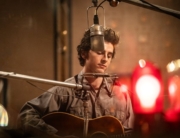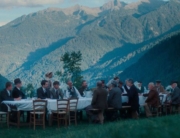This look at the life and work of choreographer Elizabeth Streb features some genuinely jaw-dropping moments. They are compiled from a career spent pushing the limits of motion in search of a kind of human flight. Of course, the first successful airplane was preceded by numerous flameouts, and Streb’s work is full of crash landings. Yet she has uniquely found a beauty in these, too, turning the slam-slam-slam of dancers hurling themselves against a wall into a beguiling rhythm.
Streb grew up the daughter of a mason, and as she watched that job ravage her father, she became compelled by the idea “that a body could be all used up by the end of its life.” She started dancing at 17, but was quickly disappointed by how “facile and gentle” the work was. So she took cooking jobs—each having its own choreography, which her muscle memory can still reproduce—to finance what would become the Streb Extreme Action Company. Then she set about using up her body and the bodies of generations of dancers.
Her company members look more like bodybuilders than ballerinas. They have to, if they’re going to bounce back after getting struck in the head by an I-beam, or scramble out of the way of what might best be described as a giant, orbiting hamster wheel. It’s no coincidence that Streb’s seminal work, a solo called Little Ease, shares its name with a medieval torture device, or that “grisly” is one of her favorite adjectives.
Accidents happen as she pushes her company to “get beyond the barrier of self-protection” in order to better isolate what she calls Pop Action. She wants muscles to create bursts of movement, instead of the more fluid shifting of weight found in most dance. One former member broke her back and was carted off mid-performance in an ambulance. “I believe it is my fault,” Streb says, with the candor she offers throughout the film. With some regret, she also acknowledges “Time doesn’t move backwards,” but neither does she.
At times there is a mystical quality to what Streb seems to be looking for. At a dinner party with dance luminaries, she ruminates on the possibility of finding “one move…that everyone would understand.” If dance is a language, Pop Action seems to be after not new words but a new part of speech, something to blow communication wide open.
Luckily, Streb’s dancers show the fervor of disciples. Even while slapping a bag of frozen vegetables on a swollen knee, the expression on their faces is more near ecstasy than anything else. “Eventually you’ll destroy yourself,” admits Hope, a former company member. These dances “celebrated my most powerful self,” she says. “I don’t think very many things in the world do that.”
Nor do many things in the world seem as stunning and beautiful as the stunts Streb manages for One Extraordinary Day, an awe-inspiring event in honor of the London Olympics. Her work has always owed something to the way photography can capture the poetry of movement, and the London visuals captured by Gund are alone worth the price of admission.
At the top of her game, Streb says the next step is taking Pop Action to the people. One humorous clip has her trying to explain it to a couple of old-school Brooklyn passersby. “It’s a little bit like a circus,” she offers, and they respond politely. No doubt seeing just a minute of the goods here would have made quite the impact (pun intended). Born to Fly: Elizabeth Streb vs. Gravity furthers Streb’s mission. Full of the beautiful and awesome, it moves along as quickly and gracefully as a great dance.







Leave A Comment